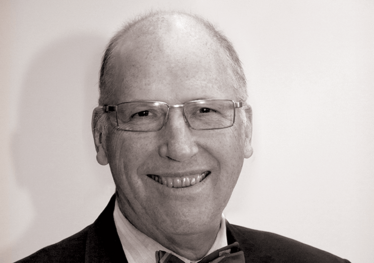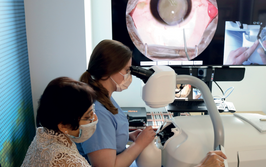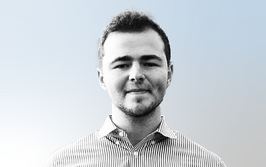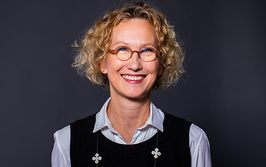The Global Ophthalmologist
Sitting Down With... Hugh Taylor, President, the International Council of Ophthalmology, Melbourne Laureate Professor and Harold Mitchell Chair of Indigenous Eye Health, Melbourne School of Population and Global Health, University of Melbourne, Australia.

Why did you choose ophthalmology?
Quite early on as a medical student I wanted to be a surgeon – I didn’t want to do internal medicine, or be a family physician or general practitioner. I had my sights set on neurosurgery for a while, but I realized that I’d be spending a lot of time in a dark room, and afterwards many of my patients wouldn’t talk to me much. Ophthalmology presented itself as a terrific combination of both medicine and surgery, and the eye itself is a beautiful organ. When you look closely, or shine a light to constrict the pupil – it’s like a little jewel box.
The other big attraction was that, at the time, ophthalmology was dealing with the really cutting edge technology, way before everybody else. Operating microscopes, the transformation of surgery, the use of lasers – it’s such an interesting and challenging field.
How did you get involved in public health?
I spent a year working with a program addressing Aboriginal eye health issues here in Australia, and that showed me how much one could do if one looked at the community rather than one individual patient – although of course, you have to treat people one at a time too. I attended the first general assembly of the International Agency for the Prevention of Blindness in 1978, and met some people from the WHO, who asked me to get involved in work in other countries. So in 1980 I spent time in Pakistan, examining children in the Afghan refugee camps, and spent around four days examining a couple of thousand children. Based on those findings, and sitting down with the WHO, UNICEF), and the UN High Commissioner for Refugees, we ordered treatment for one and a half million people. This allowed me to help many more people than I could by just treating my patients one at a time. It showed me the power of a public health approach and of dealing with much larger groups. Since then, I’ve worked closely with the WHO on a number of things.
One project on which you collaborated with the WHO is CERA…
I established the Centre for Eye Research Australia (CERA) in 1996. It had an unusual and (as far as I know) unique creation, as it involved the coming together of the University of Melbourne Department of Ophthalmology, of which I was chairman, the Royal Victoria Eye and Ear Hospital, the Royal Australian and New Zealand College of Ophthalmologists, two organizations of and for the blind, and the Lions Clubs. As a WHO Collaborating Centre for the Prevention of Blindness, it’s a large and thriving center for a broad range of ophthalmic research; from world-leading collaborations on basic research into disease mechanisms and the genetics of eye disease, to clinical trials and innovations including work on a bionic eye, to epidemiologic and health service research including work on low vision and rehabilitation. I retired as the director of CERA 8 years ago and it is wonderful to see it continue to grow under the leadership of Jonathan Crowston.
How did your work that led to the understanding of the pathogenesis of trachoma come about?
Again, it started with my work with the Aboriginal people of Australia. We’d see the same pattern – Aboriginal children with dirty faces and very high rates of trachoma, and non-Aboriginal children in the same communities with very low rates. We got the idea that perhaps they were being repeatedly reinfected. Then as a Johns Hopkins fellow, I attended the Christmas party one year and started talking with Arthur Silverstein, the ocular immunologist. He asked me what brought me to the US, and what I’d done before. So I was speaking about trachoma, and he asked me “Well, how do you get trachoma?” I explained our belief that it was caused by repeated infection, and he said “Oh, is that so? Would you like to do some animal studies to prove that?” And I said I would. So we started some research, and it was only later on that I found out that he’d had a couple of grants, and worked with a number of other people all trying to establish a model of trachoma on the basis of a single infection, and they had failed. So the key we found to understanding the pathogenesis of trachoma, was understanding the importance of repeated episodes of reinfection.
One of your current goals is to work towards the elimination of trachoma – how close do you think that objective is?
Australia has the dubious distinction of being the only developed country that still has trachoma, and it really has been a national disgrace. That said, I think we’re making some very good progress – in the last eight years, we’ve reduced the rates from 21 percent on average, to less than 5 percent. So I think we’re well on target for eliminating trachoma as a public health problem by the year 2020.
I’ve also been very involved in global efforts, and the work going on there is truly breathtaking. A huge effort has been made over the last two years in mapping all of the remaining communities that have trachoma, and something like 150 million people are receiving antibiotic treatment this year. So trachoma may not be fully eliminated in every country by 2020, but we’ve eliminated it in 10 countries already, and a lot of work has been done – so I’m confident that we’re going to come very close.
You’re working on a huge scale – including working with government. How do you get people in positions of power to make meaningful changes to public health?
Firstly, it has to be evidence-based. You need to have firm data to show what the problem is, and firm data and recommendations for the solutions. Politicians and policymakers don’t want to hear problems, they’ve already got more than enough of those. They want solutions. Next, make sure you have broad sector or stakeholder support. Because if one group approaches the minister or secretary today and says “We should do X.”, and then somebody else comes the next day saying “We should do Y”, and next week somebody comes to them saying “I know, we should do A.” It’s all too easy for the minister to say “These guys don’t know what they’re talking about. Forget it!”
If you can get everybody singing from the same hymn sheet, you’re much more likely to have a powerful presence. You’ve also got to be persistent – keep at it, and don’t walk away if you’re rebuffed. And make sure your proposal has community support and endorsement.
What would you consider your career highlights?
There are a number of things I’m proud to have worked on – such as the link between UV exposure and cataract, and ivermectin use, which has transformed where we are with river blindness, that terrible blinding scourge. I was also involved in some ground-breaking work on excimer laser treatment of astigmatism and higher degrees of myopia in the early 1990s. By bringing together the skills and resources of the university department the local private practitioners, we were able to rapidly amass and analyze large amounts of data, and push the boundaries of excimer laser surgery much more quickly than most other groups at the time.
Something else that sticks out to me is a photograph on my notice board. It shows the former Minister of Health, who later became the Attorney General of Australia, and she’s holding a plain labelled packet of cigarettes that has a big photograph of an eye on it. My colleagues and I did a lot of work on the link between cigarette smoking, cataract, and macular degeneration. Later, I realized that this data had sat around in dusty journals for 10 years, and nothing had happened. So I went to the Australian cancer council, and told them we needed to start publicizing the harmful effects of smoking on the eye. Eventually, we had TV commercials and warnings on cigarette packets, and this was later picked up in the UK, Thailand, and many other countries. To have the former Minister of Health announce the plain packaging of tobacco products, and again to emphasize that eye relation, was really gratifying. I think that was a little thing that had a big impact.
What tips would you give to young researchers hoping to make their own mark on the field?
Good research takes a lot of sustained energy. You need to have a discrete and achievable target that you’re working towards, and you shouldn’t try to do too much all at once – target only one particular area. And make sure that that area, if you can unlock it, is both important and relevant. Research that sits in a lofty journal is fine, but you really want research that goes to the next step, and helps improve lives, or in our case, people’s sight. Choose carefully, and stay focused.
You’re also president of the International Council of Ophthalmology – what would you consider to be the biggest challenges ophthalmologists face?
As president, I think my biggest challenge is that there are only 24 hours in a day, and it’s very hard to get everything done! As for ophthalmology itself, we have around 36 million people who are blind, and 280 million with low vision, and there are only about 205,000 ophthalmologists. That’s a huge amount of eyecare that needs to be delivered. We need to look at how we can work in teams, and have the ophthalmologist doing the things that only he or she can do (whether it’s cataract surgery, or detailed examination of patients), and to have other people to help and do the other tasks, so that we can work more efficiently.
Another thing we need to do is make sure that ophthalmologists are all properly trained and current in their medical knowledge. We’ve got a lot of work to do in developing countries, and we need to spend a lot of time upscaling and improving training programs, and also making sure that practicing ophthalmologists are kept up to date with continuing professional development.
What are the current challenges and opportunities in ophthalmology?
There’s never been a better time to be in medicine, or in ophthalmology. We can do more than ever before to restore and maintain sight – it’s an exciting time. When you look at the tools, techniques, diagnostics and therapeutic approaches we have, it’s quite extraordinary when you think back to where we were 10 or even 20 years ago.
I think we can develop much better ways to treat neovascular changes in the macula than monthly injections – I’m confident that the way that drugs will be introduced into the eye, and the drugs we use, will change dramatically. They’ll also need to come down a great deal in price, particularly for diabetic retinopathy, when we look at the huge number of people who need to be treated. I also think that the dream of an accommodating IOL, a truly accommodating IOL, is not far off. When that becomes available, it’s going to be transformative for the whole refractive and cataract area. Finally, I think the tsunami of diabetes that’s confronting the world is going to be a real challenge for us, and we need to work closely with primary care physicians and others, to make sure we can address the associated vision loss.
Looking back at your career so far, is there anything you wish you’d done differently?
I’ve had such a great time. It’s been a real privilege to be an ophthalmologist, and to be able to do the research I’ve done, and work with the people I have. There are still changes I’d like to see in how we practice, and you’ll always have things that succeed and things that don’t, but overall I’ve been honored – and it’s important to note that one only gets to do all these things with a lot of teamwork, partnership and collaboration.
Martha and Eddie Peterson Professor of Ophthalmology and Professor of Biomedical Engineering, Associate Director & Director of Research at the Casey Eye Institute, School of Medicine, Oregon Health & Science University in Portland, Oregon, USA













